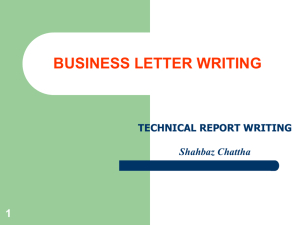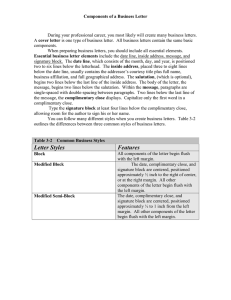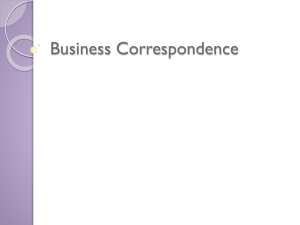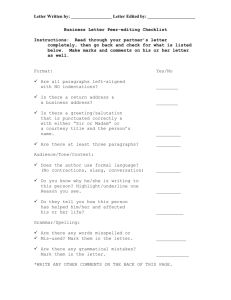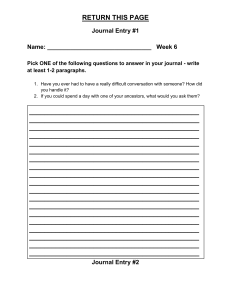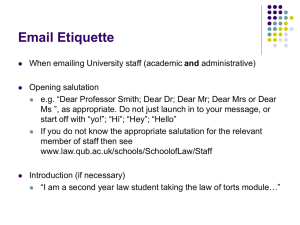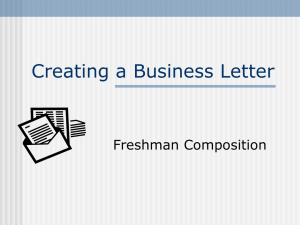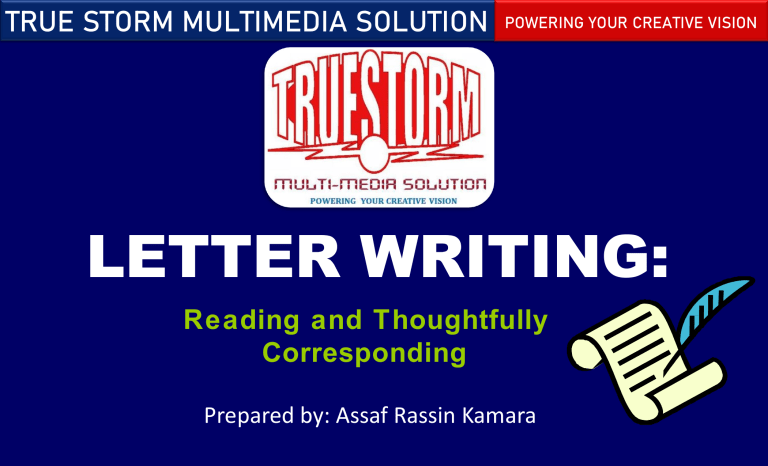
TRUE STORM MULTIMEDIA SOLUTION POWERING YOUR CREATIVE VISION LETTER WRITING: Reading and Thoughtfully Corresponding Prepared by: Assaf Rassin Kamara Objectives To teach students to read letters or letter requests carefully before responding. To teach students the importance of creating formal and informal documents. To teach students basic letter formats and letter-writing strategies. To teach students letter-writing etiquette. Definition of “Letter” LETTER “A written or printed communication directed to a person or organization.” Letters may be created and sent as: E-mail or electronic transmissions (including faxsimiles) Hand-delivered transmissions Regular mail transmissions Letter Writing Etiquette Etiquette is good manners or appropriate or accepted social practices that reflect and promote civility. When should you write a letter? To thank someone who has been gracious, kind or helpfulto you. When you need assistance or answers to help you make intelligent decisions. To respond to a letter or letter request that you have recently received. (do not wait too long) To create legal documents that record information and support claims. To show that you are a courteous, professional, detail- oriented person who is aware of etiquette. Why letter writing matters “A writer, writing away, can always fix himself up to make himself more presentable, but a man who has written a letter is stuck with it for all time.” – E. B. White Therefore . . . Letters should be truthful as they may become a permanent record of what you know, think or feel at the time you are writing the letter. Letters have come back to haunt many people. Letters reflect the character and communication skill of the writer. Before writing a letter ... Read (1) the letter or letters to which you need or want to respond; or (2) read a written announcement or article motivating or requesting a letter response. (News stories, displays and billboards, and even oral comments that others have voiced may spark your passion to write a letter. Listening, is therefore important to letter writers.) Examine the tone (language) of the letter, announcement or other printed material to which you will respond. The tone of the motivating piece helps you determine the tone of your written response (formal or informal). Identify your audience and purpose in order to determine the type of letter you will write (formal or informal). Think about / Plan your response. Letter Mechanics – 1. Pronoun (Point of View) The use of personal pronouns is important in letters . . . I, he, she, it, we, they, you In a letter, do not refer to yourself in the third person by using one or the writer. It is perfectly natural and appropriate to refer to yourself as I and to the reader as you. Letter Mechanics – 2. Focus and Specificity Be Focused; however, avoid choppy sentences. Don't be so concise that your tone is blunt. Use terminology and concepts related to the industry / field. (Jargon may be appropriate in business writing. ) Avoid vagueness. Be specific in your requests or statements of facts. Letter Mechanics – 3. Active versus Passive Voice Examples PASSIVE Sentence : It was discovered that the salary totals were incorrect. Who discovered “ it” [ the problem]? The underpaid employee, The payroll specialist, The Accounting Department, An Intern, The IRS? ( Be specific.) Revised ACTIVE sentence: The Accounting Department discovered that the salary totals were incorrect. Two categories of letters Business Letters (format writing; more formal writing that may share elements of essay writing) Personal Letters (often informal; may be addressed to a friend or familiar acquaintance about a personal subject; may regard a personal problem, issue or even a personal business matter pertaining to ones personal finances or personal legal matters) Types of Personal Letters Personal Letters . . . whether typed or handwritten, may include personal touches that reflect your style or personality. Date Salutation Special stationery (Greeting) Dear Maxwell, December 4 , 2007 I just wanted to take amoment to write to you to express my thanks for the extra tutoring help you gave me this fall as I struggled in my Math 1112 course. People like you make our world abetter place simply because you take the extra time to help others overcome fears and l earn important skills. I think I can safely say, you are going to make agreat math teacher one day! You stand head and shoulders above others in the field of math and I so appreciate the information, time and patience you provided to me. Signature So, once again, thank you so much for everything, and Complimentary especially for encouraging me Closing Best wishes, Guidelines for Writing Apologies: • Write as soon as possible after the incident. •Apologize, but do not go overboard by saying, "I am very, very, very sorry." •Keep it simple and to the point. Summarize what you are apologizing for, and apologize only for the particular situation or problem. Be brief. • Apologize cheerfully and sincerely. Do not express feelings of guilt. • Explain what you will do to correct the mistake or situation. •Do not put blame on another person and do not blame problems on computer errors or carelessness. Sample Complaint Letter mm/dd/yyyy To Betty Grimes, I am writing to inform you that your daughter, Sarah, broke the front passenger window of my Ford Taurus while playing softball yesterday afternoon. The car is brand new. Hopefully, your homeowner's insurance will cover this kind of damage. Please check with them to see if it is covered. If they will not pay for it, I will get two repair estimates for you so that you can determine how you will pay for the repair. Perhaps we could meet this Saturday afternoon to discuss our options. You can reach me at (202) 555-1098. Thank you for your timely attention to this matter. Thank you, Rita Green Rita Green 124 Huckabee Littletown, AL 34567 When to Write a Personal Thank You, congratulations or Appreciation Letters To thank or show gratitude for: Gift Group efforts Introduction to other people Invitations to speak Helpful advice or suggestions Personal favors Recommendations for position or awards References Sympathy Volunteers Graduations Guidelines for writing personal appreciation / thank you letters: State what you appreciate and briefly explain why. Do not add other news or information not related to the appreciative gesture Be brief, warm, and sincere. (Two to three lines should suffice.) Example: Thank you for the character reference you provided to Troy University on my behalf. I truly appreciate your willingness to provide the reference, as well as your time and attention to completing it. Again, thank you, and best wishes. – Tina Applicant Postcards may be used for short notes. Personal notes should be handwritten. Writing an Invitation (Formal (Business) or Informal Events) Mr. and Mrs. Benjamin Raphael-Leon cordially invite you to a reception celebrating the engagement of Identify date/ time/ location of event. Mary Jane Raphael-Leone & Robert Wilson Yates to be held Sunday, the sixth of June, in the year two thousand and eight, at six o'clock in the evening at Pierre's Cafe 800 23rd Street NW Washington, DC. Semi-formal dress RSVP (202) 555-6908 yourself and one guest. Thank you. Identify the host and type of event. Identify guests of honor (if applicable). Practice Exercise – Personal letter (choose two) Write a thank you letter/note card to someone who has recently helped you write a congratulatory letter/note to someone who has recently achieved an outstanding honor. Design an invitation to an event you will host December 22, 2007. Practice Exercise Create an invitation or personal letter/note. Business Letters Business letters are documents created to: o persuade or inform readers (Ex: a letter from a candidate requesting your vote) o analyze a concept or situation (Ex: a letter from the human resources manager explaining the new payroll deposit system to company employees) o propose a solution (a letter offering a plan to reduce or prevent school violence) o correct some perceived error or miscommunication. (Ex: a letter to a creditor about a billing error you have noticed) Business Letters Format Writiing Common Types of Business Letters To write any type of • Acceptance Letter (yes/ legal) • Acknowledgement Letter (Receipt) •Adjustment Letter (a legal document / addresses a complaint or claim) • Application Letter (request job consideration/ interview) • Complaint Letter (a legal document) • Cover Letter (accompanies resume or order) • Inquiry Letter (posing a question) • Order Letter (request letter) • Refusal Letter (reject an offer) • Response Letter (answers inquiry) • Sales Letter (marketing) business letter, follow these basic steps: • Identify your reader • Establish your objective • Determine your scope (how much researched information to include ) • Organize your letter • Draft your letter • Close (End) Your Letter • Review and Revise Your Letter (proof for physical problems and edit for logic issues) Source: Business Letters. Retrieved Dec. 3, 2007, from http://writing.colostate.edu/guides/documents/business_writing/business_letter/ General Parts of every Business Letter Heading (sender‟s return address and date) Inside Address (recipient‟s address) Salutation (greeting) Body (paragraphs) Complimentary Close Signature Line (with or without title) Enclosure (optional) cc notation (copies sent to others) Sender/typist initials (optional) General Statements about Business Letter Writing “Business letters [are] required in many different situations . . . from applying for a job to requesting or delivering information.” Writing for business should be “crisp and succinct. It should be to the point, specific and accurate.” “Even though business writing is possibly less formal than it once was, your writing must . . . adhere to the conventions of standard American English” (spelling and grammar rules) Source: http://www.unc.edu/depts/wcweb/handouts/business.html General Letter Layouts / Styles Modified Block Style Block Style Semi-block Style http://www.englishplus.com/grammar/00000144.htm Letter head 1. Block Style (Simplified) Letter Format SAMPLE Everything flush to left margin with no indents. Signature Block: Align this with the Complimentary Close. Leave four blank lines to sign your name. Don‟t forget to sign your name exactly as you typed it. Your title is optional and depends on the relevancy and degree of formality you need or want to establish. Source:http://jobsearchtech.about.com/od/letters/l/bl_ mblock_ p.htm 2. Modified Block Style Letter Format SAMPLE Paragraphs are not indented; however, these parts of the letter are centered: • Sender’s return address • Date letter written • Complimentary closing http://www.englishplus.com/grammar/00000144.htm Company Logo or Letterhead March 15, 2007 Mr. John Smith, Director of Operations SomeGroup Group 100 SomeStreet Drive Sometown, Alabama 34567 Dear Mr. Smith: 3. Semi-block Style Letter Format SAMPLE Thank you for your inquiry about Semi-Block format for letters. What follows is a quick summary of the format and the conventions it uses. Semi-block format or style is frequently called modified semi-block because it is a slightly less formal modification of full block format. This letter style places the date line in alignment with, or slightly to the right of dead center. Another option for placing the date line in semi-block is flush right. Similar to full block, semi-block places the inside address, salutation and any end notations flush with the left margin. However, unlike full block, each body paragraph of semi-block is indented five spaces. The complimentary close and signature block are aligned under the date. This page illustrates the spacing and layout of semi-block format. Both full block and semi-block formats generally contain all of the necessary parts of a letter. Sincerely yours , Dr. Sheila Carter-Todd Indent paragraphs 5 spaces. Everything else is flush at the left margin. Business Letter Salutation / Greeting A Business letter‟s text starts with a simple and professional greeting such as, The Word Dear, Mr./Ms./Title, & Last name of Person:” Examples Dear Dr. Smithsonian: Dear Ms. Cleopatra: The difference between personal and business letter greetings is that a colon (:) follows the greeting of a business letter and a comma (,) follows the greeting of a personal letter Body A generally acceptable format for the body of most business letters is block style, with no indentions or centering of any parts . Paragraphs should also be single spaced within the paragraph and double spaced between different paragraphs. Business Letter Content Each paragraph in the business letter should contain different topics. The first paragraph should grab attention and state the reason for the letter. The middle paragraphs, as in most letters, should support your reason and go into details. In the final paragraph, it professional etiquette for the writer to thank the reader for taking his or her time to read the letter. Closing The end of a business letter marks the biggest difference between business and personal letters. The ending of a business letter usually states „Sincerely,‟ followed by three blank lines for the writer‟s signature and then the writer‟s typed name. Letter-writing Practice Exercise: Response letter Behave as if you have just received the Letter of Application in the next slide. You must notify the person that he or she did not get the job and that your company has recently filled the advertised position. Write a one-paragraph letter to the applicant. (See upcoming slide for a suggested approach to writing the letter.) Read this Sample Business Letter (Letter of Application) below. Sender’s Return address Inside address (receiver) Taylor, Inc. Mr./Ms. S. Student, Human Resources Director 694 Rockfoot Lane Durham, North Carolina 27708 Dear Mr./Ms. Student: 6123 Farrington Road Troy, Alabama 27514 January 11, 2007 This letter is written in Modified Block Style. Indent the sender’s address, letter date, complimentary close, & signature. Everything else is flush to the left margin. Single Space throughout, except double Space between new paragraphs. Center letter on the page. I just read an article in the News and Observer about Taylor's new computer center just north of Durham. I would like to apply for a position as an entry-level programmer at the center. I understand that Taylor produces both in-house and customer documentation. My technical-writing skills, as described in the enclosed resume, are well suited to your company. I am a recent graduate of Troy University in Troy, Alabama, with an Associate's Degree in Computer Science. In addition to having taken a broad range of courses, I served as a computer consultant at the college's computer center where I helped train computer users on new systems. I will be happy to meet with you at your convenience and discuss how my education and experience match your needs. You can reach me at my home address, at (919) 233-1552, or at crock@devry.alumni.edu. Complimentary Closing Sincerely, Raymond Graduate Suggestions for Responding Reminder to supply address information. Include salutation. Acknowledge receipt of the application package. Thank the applicant for his interest. Notify the applicant that the position has been filled. Let the applicant know that you will keep the application packet on file. PLEASE CONTACT US WITH ALL YOUR PROFESSIONAL DEVELOPMENT TRAINING NEEDS: 7 MACAULEY STREET OFF CIRCULAR ROAD. FREETOWN TEL: +23276772873 / +23234095378 EMAIL:
